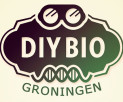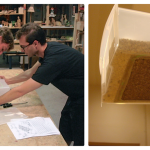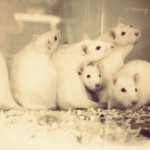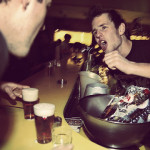Do-It-Yourself Biology
Two years ago, applied physics master’s student Winand Slingenbergh, molecular biology PhD candidate Claudio Tiecher and polymer chemistry and bioengineering PhD candidate Alessio Marcozzi decided to found the DIYbio Groningen community out of common interest and curiosity.
The members define themselves as a vibrant community of makers and Do-It-Yourself biologists who are aiming at rethinking the way science is approached. The group currently consists of five active members who all come from different scholarly backgrounds including biology, informatics, physics and social sciences, but everyone who is interested in exploring is welcome to join.
Accessible biotechnology
‘The aim of the project is to make biotechnology publicly accessible so that everyone can benefit from it’, Claudio says. ‘Our goal is to spread knowledge and thereby empower the people so that they can pursue their own projects and answer their own questions.’
The group found a host in the foundation De Jonge Onderzoekers where their regular Friday night meetings take place. The foundation offers educational activities on technology and science for young people between the age of 8 and 18.
The foundation is in a colorful and spacious space, equipped with all the necessary tools and instruments for conducting experiments and other technical activities. Joiner´s benches, computers and fish tanks with polliwogs are at visitors’ disposal.
- Members of DIYBio work on a project for cultivating mealworms. Photo credit: diybiogroningen.org
While Claudio explains what their community is all about, another member teaches a group of children how to program a machine to create sounds. Complex coding is projected onto a large screen that appears pretty complicated for the average person, but the kids seem to get it: soon, the machine begins emitting noises.
All experiments can be conducted outside of special labs and are nonhazardous. In general, no special equipment is needed for the experiments and the members try to make use of their own resources.
Experiments
However, in order to hold a workshop on the thermal cycler or PCR machine – a laboratory apparatus that is used to duplicate segments of DNA – the group borrowed a machine from the RUG. One of the many projects that the community is currently working on is building a do-it-yourself PCR machine: the device costs several thousand euros on the regular market, but by recreating the machine on as low a budget as possible, the group hopes to make it accessible to everyone.
‘We are currently expecting costs of around 150 euros for all the materials needed’, Claudio says. ‘If we succeed in building the machine, it will enable us to conduct a lot of future experiments.’
Another project is the farming of mealworms. The goal of the experiment is to follow the life cycle of the worms in real-time – transforming from worms into pupae and beetles – and to see if they can function as an alternative food source in the future. The group fabricated a custom-made mealworm nursery in a plastic dresser for this project. In each drawer, you can find the species in another stage of life, from eggs to hundreds of worms crawling around in sawdust to pupae and finally, in the top drawer, the squirming mealworm beetles.
Disciplines converge
Different disciplines converge with each other on some projects, as was the case when DIYbio Groningen collaborated with an artist who was working on a bioart design project and was seeking bacteria that can create ink. The group also organizes workshops and events on a regular basis such as the ´Strawberry DNA – Extract it Yourself´ in order to engage a larger audience with biology and biomolecular sciences. Do-It-Yourself instructions and recipes are often published on the website so that everyone can access them for free, even if they haven’t visited the lab in person.







